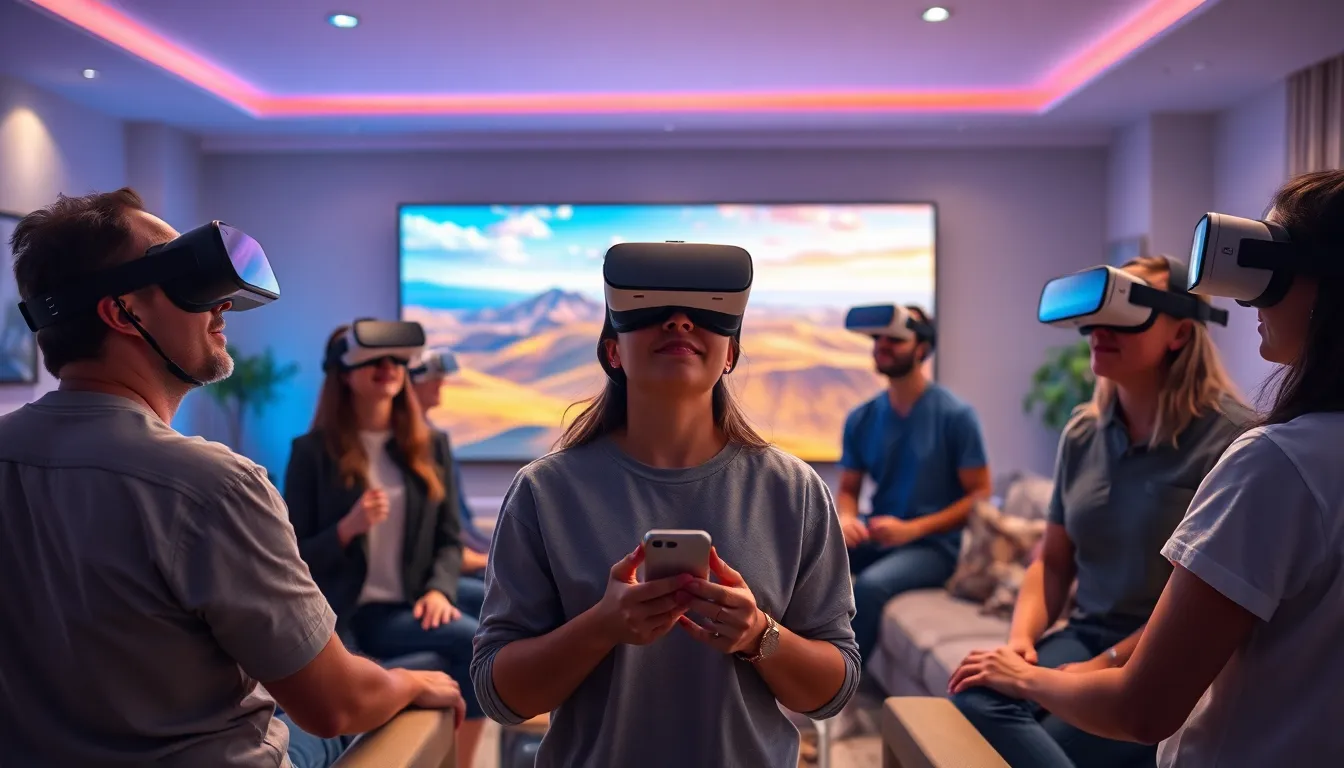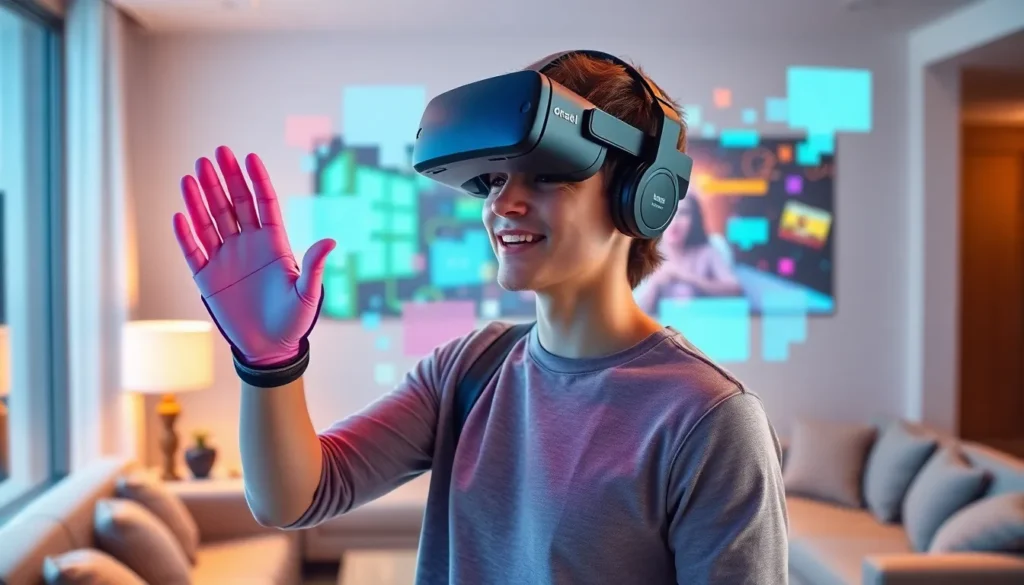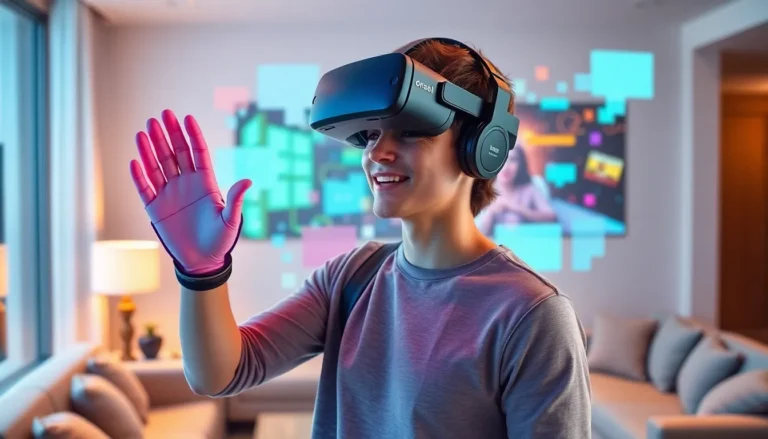Table of Contents
ToggleVirtual reality has taken the tech world by storm, transforming how people game, work, and even socialize. With the right VR headset, users can dive into immersive worlds that make reality feel like yesterday’s news. But with so many options out there, choosing the best one can feel like navigating a maze blindfolded.
Overview of VR Technology
Virtual reality (VR) technology creates interactive, computer-generated environments that users can explore and manipulate. Headsets feature advanced displays, sensors, and audio systems, producing an immersive experience. They transport users into alternate realities, enhancing gaming, training, and social interactions.
Tracking technology plays a crucial role in VR. Sensors monitor head movements and hand gestures, enabling real-time interaction with virtual elements. Most headsets now incorporate inside-out tracking, eliminating external sensors for ease of use. Platforms like Oculus and HTC have established themselves by offering comprehensive VR experiences with high fidelity.
Industries leverage VR for various applications. Training programs utilize VR to simulate work environments, providing safe settings for practice. Medical professionals employ VR for surgical simulations, allowing them to refine their skills without real-life consequences. Additionally, educational institutions use VR to create engaging learning experiences.
Content availability is vital for any successful VR headset. Access to a broad library of games and applications influences user experience significantly. Popular titles like Beat Saber and Half-Life: Alyx showcase the potential of VR gaming. Subscription services, such as Oculus Game Pass, enhance the value by providing a rotating selection of content.
Compatibility with other devices remains critical. Many VR headsets connect seamlessly with gaming consoles and PCs, broadening their usability. Standalone headsets offer convenience without the need for external devices, making them accessible for casual users. As technology continues to evolve, VR experiences are expected to become even more refined and universally applicable.
Criteria for Selecting the Best VR Headsets

Selecting the best VR headset involves evaluating several key criteria. Each criterion impacts the overall user experience and plays a significant role in how immersive the VR environment feels.
Display Quality
Display quality represents a pivotal aspect of VR headsets. A headset with a higher pixel resolution offers crisp visuals, enhancing the immersive experience. Refresh rates above 90 Hz improve motion fluidity, reducing motion sickness. Additionally, field of view impacts perception; wider angles create a more natural view. A color accuracy also enriches the visual experience, making environments appear lifelike. Notable headsets like the Valve Index excel in display quality, providing impressive specifications that attract users.
Comfort and Ergonomics
Comfort directly affects usability during extended sessions. A headset that distributes weight evenly minimizes fatigue, allowing for longer usage without discomfort. Adjustable straps help accommodate different head sizes, enhancing the overall fit. Foam padding and breathable materials contribute to a comfortable wear, reducing sweat and irritation. Users often prefer lightweight designs, which prevent neck strain during long gaming or training sessions. The Oculus Quest 2 stands out for its ergonomic design, making it suitable for hours of immersive interaction.
Tracking and Motion Controllers
Tracking systems and motion controllers determine how effectively users interact with the virtual environment. Precise tracking enhances immersion, as accurate movement leads to a seamless experience. Inside-out tracking removes the need for external sensors, adding ease of use and flexibility. Motion controllers should provide haptic feedback, creating a sense of touch that enhances realism. Devices like the HTC Vive Pro utilize advanced tracking technologies to offer reliable and responsive controls. Reliability, responsiveness, and technology integration significantly shape the VR experience.
Top VR Headsets on the Market
Several high-quality VR headsets dominate the market, each offering unique features and capabilities. Here are some of the top contenders:
Oculus Quest 2
Oculus Quest 2 stands out for its affordability and portability. Users enjoy a wireless experience with a library of games and applications. With a resolution of 1832 x 1920 pixels per eye, this headset delivers sharp visuals, making gameplay immersive. Its hand tracking feature enhances interactivity, while compatibility with PC allows access to even more content. The lightweight design promotes comfort for extended sessions, appealing to both casual gamers and VR enthusiasts.
HTC Vive Pro 2
HTC Vive Pro 2 excels in display quality and tracking technology. Featuring a 2448 x 2448 resolution per eye, it offers stunning visual experiences, ideal for simulation enthusiasts. Its advanced tracking system with external base stations ensures precise movement recognition. This headset supports a wide range of accessories, enhancing versatility. Comfort is also prioritized, with adjustable straps and high-quality materials designed for prolonged use.
Valve Index
Valve Index is celebrated for its premium build quality and innovative features. It boasts a resolution of 1440 x 1600 pixels per eye and a high refresh rate of 120 Hz, providing smooth visuals. The finger-tracking controllers enhance interaction, bringing a new level of immersion. Users appreciate the wide field of view that deepens the sense of presence. As a PC-tethered device, it connects seamlessly to a vast library of VR content, making it a favorite for serious gamers.
PlayStation VR
PlayStation VR caters to console gamers with its integration into the PlayStation ecosystem. While the resolution is lower at 1920 x 1080 pixels, the library offers engaging experiences like exclusive games. It utilizes the PlayStation Camera for motion tracking, ensuring decent responsiveness. Comfortable design allows for enjoyable extended gameplay. Its affordability makes it accessible for users who seek an entry into VR without a hefty investment.
Future of VR Headset Technology
Advancements in VR headset technology shape the expected trajectory for immersive experiences. Innovations such as augmented reality (AR) integration are likely to enhance user engagement by blending the real and virtual worlds. Developers continuously improve visual fidelity, with higher resolutions and dynamic refresh rates becoming standard.
Wireless capabilities increasingly dominate market trends. Many users prefer the freedom of movement that wireless headsets offer, leading manufacturers to prioritize untethered experiences. Meanwhile, eye tracking technology emerges as a game-changer, facilitating personalized adjustments to enhance comfort and reduce fatigue.
Collaboration with artificial intelligence enhances interactivity. AI-powered features may lead to more intuitive user interfaces and adaptive environments, creating seamless interactions. Companies like Meta and HTC are already investing in research to expand applications beyond gaming, focusing on education, training, and social interactions.
Content diversity will play a crucial role in the future. As more developers create VR-specific content, users can expect a broader range of experiences. The integration of social platforms within VR headsets enhances communal experiences, providing opportunities for shared engagements without physical presence.
Finally, accessibility features will gain importance. Inclusive design ensures that individuals with disabilities can also enjoy VR experiences, expanding the user base. As technology evolves, VR headsets will likely redefine how people connect, learn, and play.
The landscape of virtual reality continues to evolve rapidly. As technology advances VR headsets are becoming more accessible and user-friendly. With options catering to various needs and preferences users can find a headset that suits their lifestyle whether for gaming work or social interactions.
The future holds exciting possibilities with innovations like augmented reality integration and enhanced wireless capabilities. These advancements promise to create even more immersive experiences that redefine engagement in both virtual and real worlds. As VR becomes increasingly integrated into everyday life its potential will only grow making it an essential tool for entertainment education and beyond.






